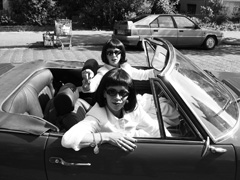Cinéma Invisible—The Book
Cinéma Invisible—Het Boek THE NETHERLANDS / 2005 / Dutch / Color, B&W / Video / 73 min
THE NETHERLANDS / 2005 / Dutch / Color, B&W / Video / 73 min
Director: Kees Hin
Script: K. Schippers, Kees Hin
Photography: Sander Snoep
Editing: Barbara Hin
Sound: Menno Euwe, Erik Langhout
Music: Otto Ketting
Producer: Rolf Orthel
Production Company, World Sales: DNU Film B.V. (Rolf Orthel)
Our guide is a woman who visits a bookstore in search of Anthologie du Cinéma Invisible, a collection of one hundred unfilmed screenplays published to commemorate the first centenary of cinema. From these unrealized works, the essence of ten projects are selected and given life. Inserting clips from Chaplin and Clouzot, Zazie dans le métro, Battleship Potemkin and more, this documentary is a playful fantasy that pays homage to all of cinema.
[Director’s Statement] The style of the film maneuvers a difficult course between the world of René Clair’s The Italian Straw Hat and Zilah, the last work by K. Schippers. The book is in actuality a poem disguised as a novel. It is a quest for purity—the way children discover the world through the games they play, the way they take in letters literally in their imagination, the way they conjure with concepts or landscapes. It is the last moment when they create their own world before they have to accept the reality of the world of adults. That is what we feel in the screenplays from the book Anthologie du Cinéma Invisible. This film pays homage to the desires and the aims of the writers of these scripts.
The structure is like that of a fan: the variety with which different people tackle the film medium means that the sequences have to be as different as possible, each with their own identity. Yet they form a unity in a strange way—think of the repeated “documentary” introductions that precede each sequence, for instance. In addition, typical cinema tricks are not avoided. The wad of paper, reminiscent of The Red Balloon, will float around town—elegant, cheerful and curious, forming a playful unity.
 Kees Hin
Kees Hin
Born 1936 in Amsterdam, Kees Hin began his career in 1962 as an assistant to world-famous documentary filmmaker Bert Haanstra. The documentary Underground (1965), marked his directorial debut as well as the beginning of a life-long scenario cooperation with Dutch novelist K. Schippers. His continuing search for original storytelling methods has resulted in an intimate style of filmmaking that displays his idiosyncratic view on reality with a mixture of documentary, feature film, theater and sometimes music. A recurring theme in his work is how memories continue to shape one’s existence. He has directed over ninety-five films, including many portraits of great painters, musicians and poets for Dutch television, as well as various documentaries on themes related to the Holocaust. His complete oeuvre received the L.J. Jordaan Prize in 1985. Works include The Sensitive Plate (1976), The Extended Death of Jacques Rigaut (1980), Soldiers without Guns (1984), A Cloud of Green (1990), Shadowland (1992), Theresiënstadt: Film or Truth (1995), A Language with a Stranger (1998) which was screened at YIDFF ’99 World Special Program, The Final Days of the Atelier of Frans van de Staak (2002), and Woyzeck—A Man Becomes a Murderer (2005). |
